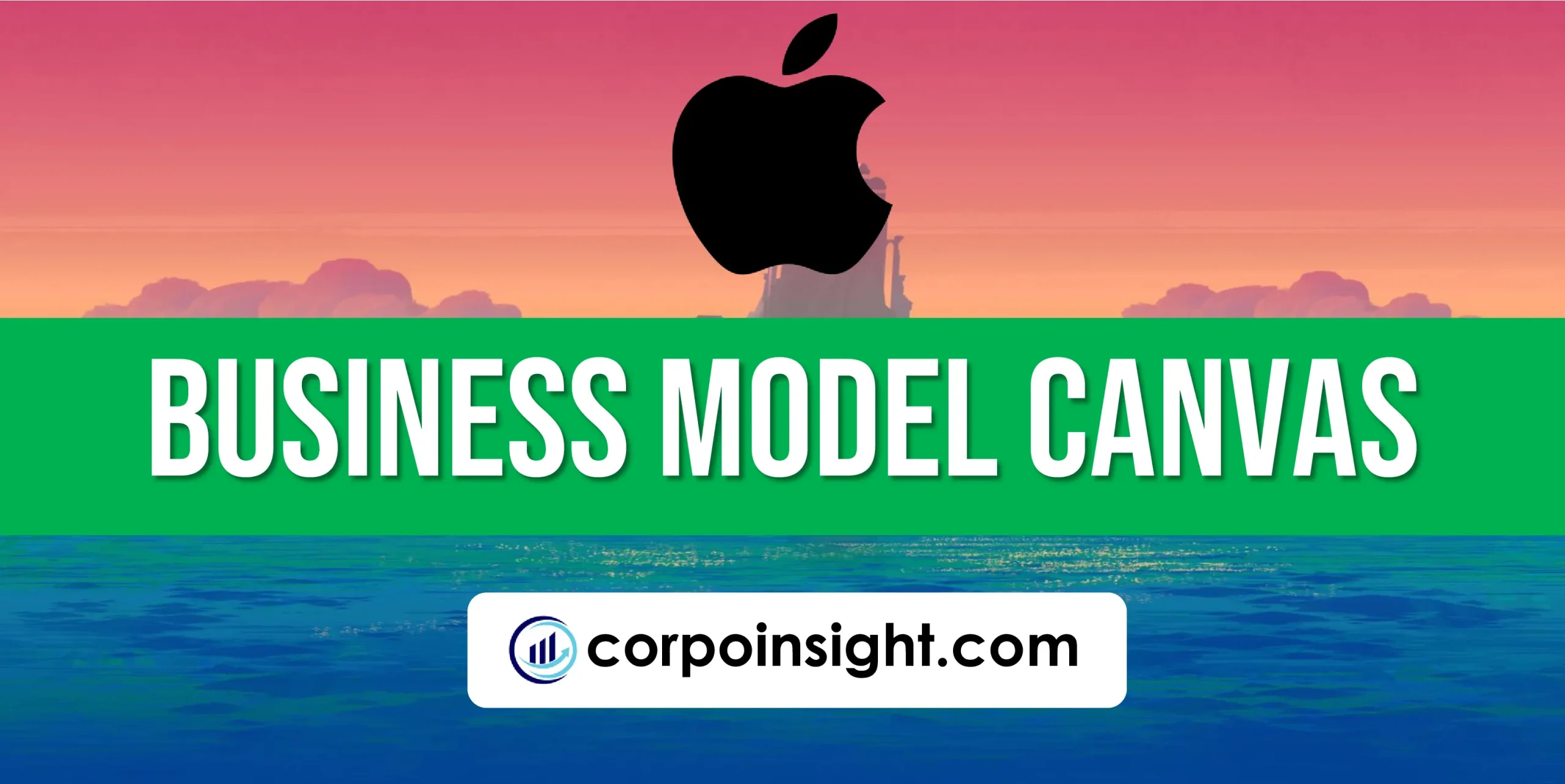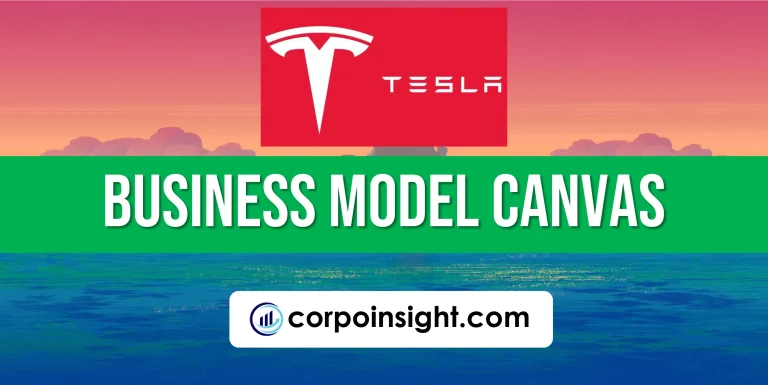Apple Business Model Canvas 2024
Apple is a dominant force in the technology industry, led by iconic products and services centered around design, user experience, and its ecosystem of apps and solutions. In this Apple business model canvas, we will learn Apple’s customer segments, value proposition, revenue streams, channels, customer relationships, key activities, key resources, key partners, and cost structure.
Interesting Facts!
Microsoft saved Apple from bankruptcy in 1997 by investing $150 million into the company.
Apple Competitors
Microsoft | Samsung | Alphabet Inc. | Amazon | Huawei | Dell | Lenovo | HP | Sony | Xiaomi
Customer Segments – Apple Business Model Canvas
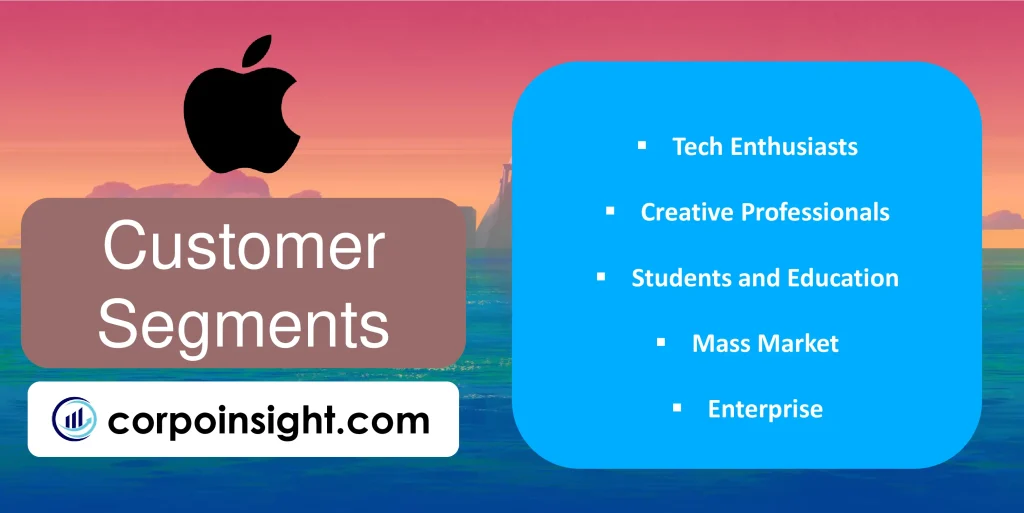
Tech Enthusiasts: This demanding segment seeks the latest and most innovative devices. For example, early adopters lined up for the first iPhone in 2007, paying $499-$599. Now, early adopters pay $999+ for iPhones with Apple’s newest features like Dynamic Island.
Creative Professionals: Apple has cultivated loyal creative pros for decades with user-friendly video editing, photography, design, and music production software optimized for Macs. The new MacBook Pro with M2 chips continues this focus on power users.
Students and Education: Apple has deep ties in education. In 2022, Apple stated over 1 billion iPads were used across schools. The iPad’s pencil, keyboard case, and software are tailored for notetaking, assignments, and portability between classes.
Mass Market: While Apple focuses on premium products, lower-cost older models help make iOS accessible to the mass market. The iPhone 11 and XR at $499 are affordable ways to access Face ID, Apple Pay, iMessage, iOS apps, and more Apple services.
Enterprise: Over 85% of companies in the Fortune 500 have deployed or piloted iOS devices. Enterprise-level management tools have unlocked Apple device usage in business. Partnerships with IBM, Cisco, and Deloitte have also made Apple enterprise-ready.
Value Proposition – Apple Business Model Canvas
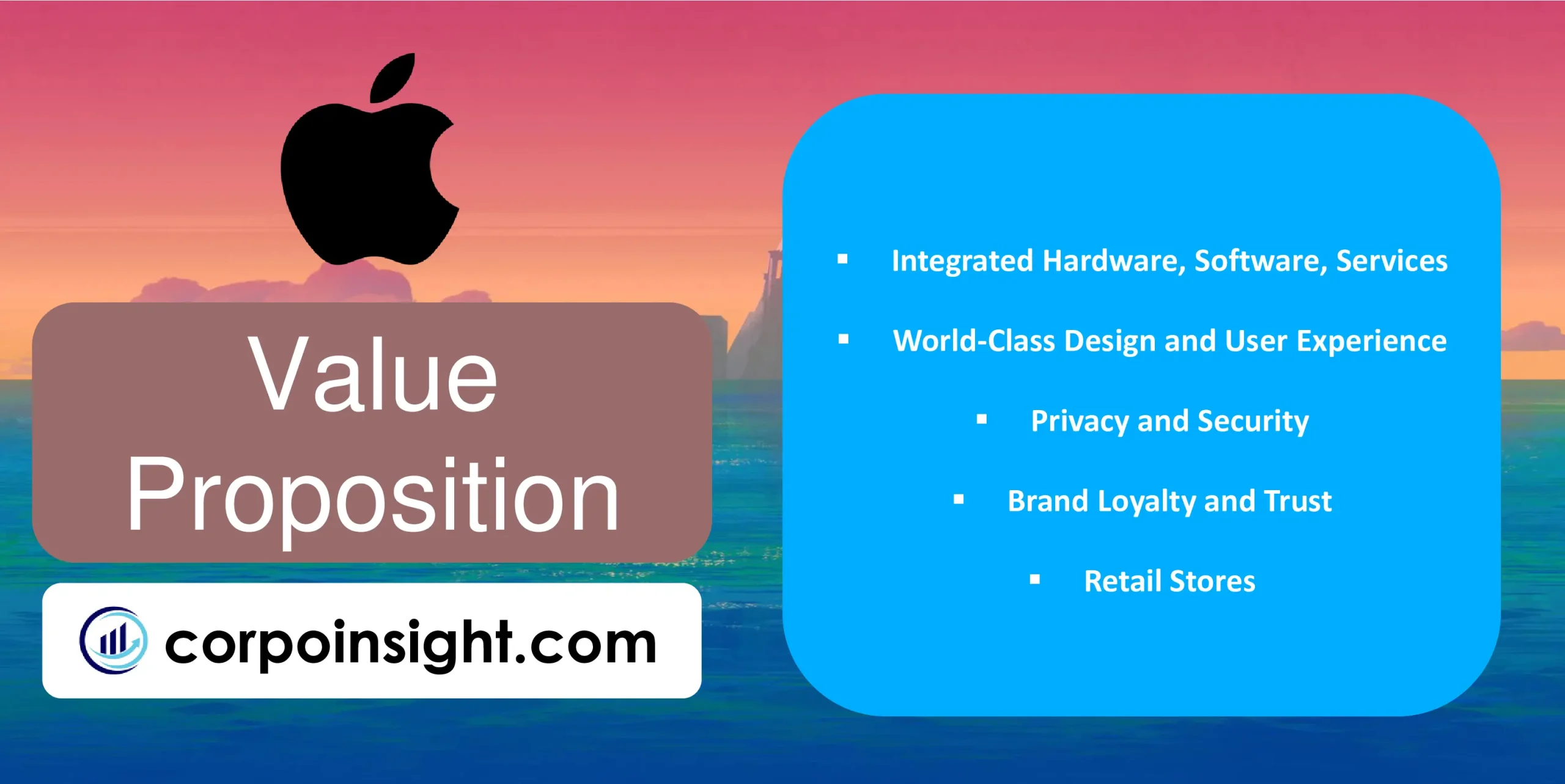
Integrated Hardware, Software, and Services: Apple controls the end-to-end user experience across iPhone, iPad, Mac, Apple Watch, and more, integrating hardware, OS software, and services like iCloud, Apple TV+, Apple Music, and Apple Pay for a seamless ecosystem.
World-Class Design and User Experience: Apple products are widely regarded for premium industrial design and intuitive user experiences. The Apple Watch Ultra offers a lightweight, durable titanium case and action button to complement fitness tracking.
Privacy and Security: Apple touts privacy as a “fundamental human right” and builds proprietary chips like the M1 to offer industry-leading privacy controls and on-device encryption, securing user data like Health app information.
Brand Loyalty and Trust: Surveys show Apple topping brand loyalty charts across ages and countries. The brand carries trust and affinity, making Apple fans willing to pay higher premiums for access to the latest iPhones, MacBooks, and innovations.
Retail Stores: Over 500 Apple Stores globally provide personalized service plus hands-on education and entertainment, further driving the community and lifestyle aspect of the brand beyond just fast transactions.
Revenue Streams – Apple Business Model Canvas
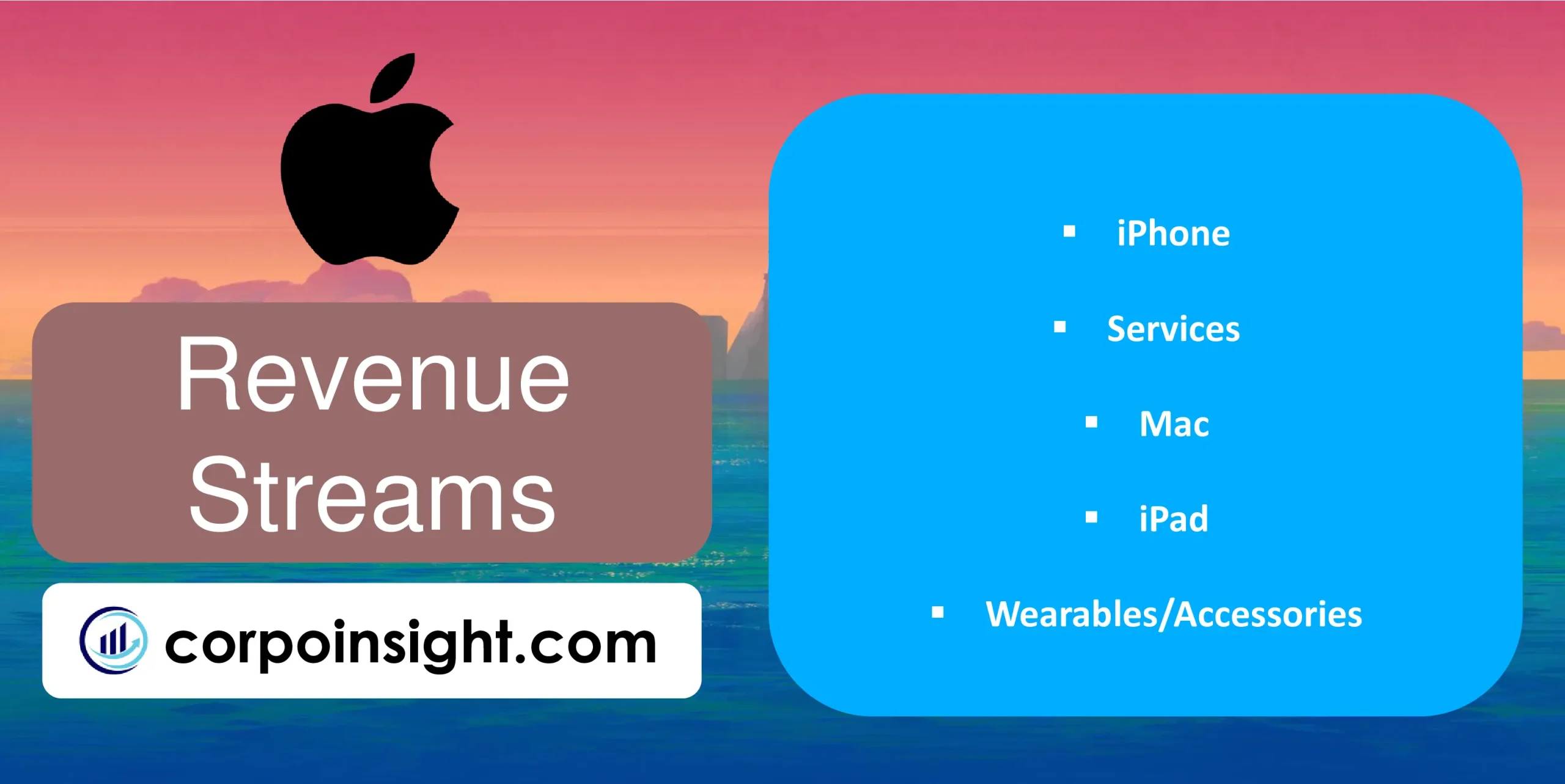
iPhone: iPhone sales accounted for 52% of Apple’s 2022 revenues at $192.8 billion. The iPhone 14 series, with a new dynamic island, always-on display, satellite connectivity, and crash detection technology, highlights continuous hardware and software innovation.
Services: Services like the App Store, Apple Music, iCloud, AppleCare, and more generated 19% of Apple’s 2022 revenues at $78.1 billion, up 10% year-over-year, showcasing the stickiness of Apple’s ecosystem. Services drive recurring subscription revenue.
Mac: With the transition to Apple silicon M1 and M2 chips complete, Mac computers contributed 11% of 2022 revenues, hitting $35.2 billion on 31% growth driven by upgrades to new, more powerful MacBook Air and Pro models.
iPad: iPad sales bounced back 26% year-over-year in 2022, hitting $29.6 billion or 9% of total revenue thanks to remote work/learning demand and the new iPad Air with M1 chip offering desktop-class performance in a thin tablet design.
Wearables/Accessories: AirPods, Apple Watch, Beats, and more wearables plus accessories like HomePod brought in $38.4 billion in revenue in 2022, up 10% and now Apple’s third largest product category.
Channels – Apple Business Model Canvas

Online Store: Apple’s website and online Apple Store app generated major direct-to-consumer e-commerce sales, such as a “record $64 billion in 2022,” according to Apple’s Q1 2023 earnings release. Online sales provide convenience plus custom configurations.
Retail Stores: Apple’s network of over 500 strategically located retail stores in prominent shopping areas spurred further growth, as stores drew “a quarter billion visitors” in 2022. Today, Apple Store retail remains important for introducing new products via hands-on demos.
Carriers and Resellers: Apple has partnered with carriers like AT&T, Verizon, and T-Mobile for several iPhone cycles to offer attractive promotions tying cellular plans with device pricing via subsidies and installment plans. Third-party resellers also help expand distribution.
Enterprise Sales Force: Apple now has many enterprise partnerships with Deloitte, IBM, Cisco, and more. An enterprise Apple sales team works closely to support large corporate iOS device deployments with tailored services and management.
Education Institutions: Education channels see aggressive Apple participation in securing iPad, Mac, and other hardware deals with school districts by touting security, ease of management, and creative use cases for learning engagement relative to Chromebooks.
Customer Relationships – Apple Business Model Canvas
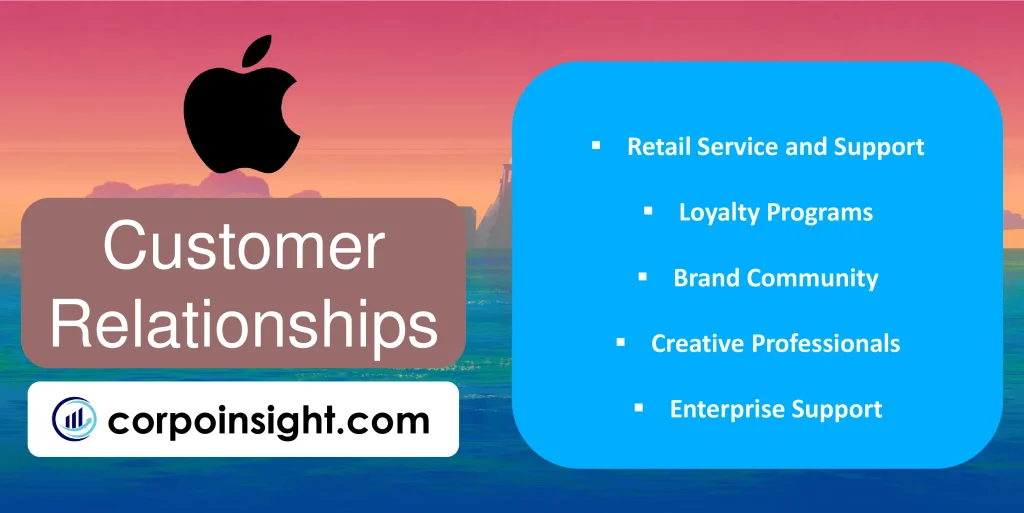
Retail Service and Support: Apple’s retail stores facilitate deep customer relationships by resolving service issues at Genius Bars plus offering Today at Apple free workshops on photography, music, coding, and using products. Apple touts stores resolving 18 million support cases per year.
Loyalty Programs: Apple aims to retain users within its ecosystem using subscription services like Apple One bundles across Apple Music, iCloud, TV+, Apple Arcade, etc. Combined with device upgrades and financing plans, these cultivate sticky long-term user relationships.
Brand Community: Apple fosters a sense of community, belonging, and identity with its brand, products, and ideals, which fans relate to. Surveys show over 90% retention rates for iOS versus Android. Events like WWDC also strengthen community ties.
Creative Professionals: Apple maintains strong credence creative users rely on for film, photography, design, etc, with specialized hardware like Mac Pro, Pro Display XDR plus optimizations across macOS and iPadOS for fluid creative app integration.
Enterprise Support: To permeate huge Fortune 500 customer bases, Apple provides enterprise support via partnerships with IBM, SAP, and Cisco, offering customized iOS deployments, management platforms, on-site service, training, and guidance tailored for big business.
Key Activities – Apple Business Model Canvas

Research and Development: Apple invests heavily in R&D, spending over $20 billion in 2022 alone to drive silicon chip design with Apple Silicon plus contribute foundational technologies across Apple products and services ecosystems.
Industrial Design: Apple’s industrial design results in iconic product designs leveraging proprietary methods, custom alloys, and skilled artisans to perfect premium materials and finishes for new iPhones, iPads, Macs, and accessories annually.
Software and Hardware Integration: Tight integration between hardware like M2 chips and software like macOS Ventura gives Apple control over the end-to-end user experience with optimizations enhancing performance, battery life, apps, continuity features, and more.
Manufacturing and Supply Chain: Apple coordinates a global supply chain featuring major iPhone assembler Foxconn to source components and manage contract manufacturers, fulfilling demand forecasts while maintaining high standards.
Retail and Online Stores: Retail remains important for deepening customer relationships via Genius Bar support, Today at Apple sessions, and elevated shopping experiences, while online handles a growing proportion of direct sales.
Key Resources – Apple Business Model Canvas
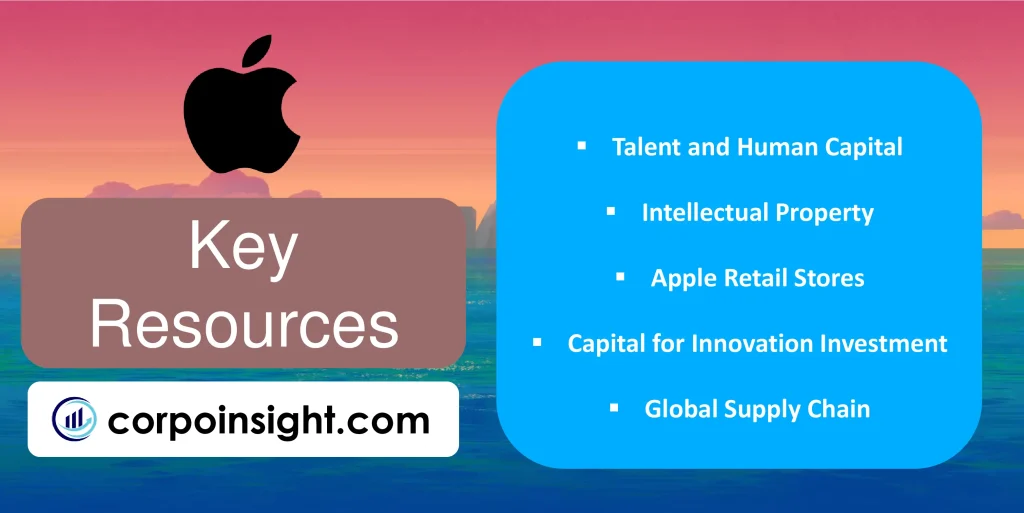
Talent and Human Capital: Apple employs over 154,000 full-time employees globally as of 2022, many world-class engineers and designers driving innovation, plus retail staff delivering customer service through stores.
Intellectual Property: Apple has over 30,000 current patents and invests over $20 billion annually in R&D to continue IP creation in silicon, software, and services. This results in proprietary technologies that differentiate Apple products and experiences.
Apple Retail Stores: With over 500 impressively designed retail stores located strategically in premium venues, Apple delivers immersive shopping, service, support plus events cultivation community bonds and early access seeding demand.
Capital for Innovation Investment: Apple has tremendous financial resources, with 2022 annual revenue over $394 billion and net income over $100 billion. This feeds massive R&D budgets funding multi-year projects.
Global Supply Chain: Apple controls complex global supply chains featuring component suppliers and manufacturers meeting demand forecasts while implementing standards for labor, waste, emissions, and human rights.
Key Partners – Apple Business Model Canvas
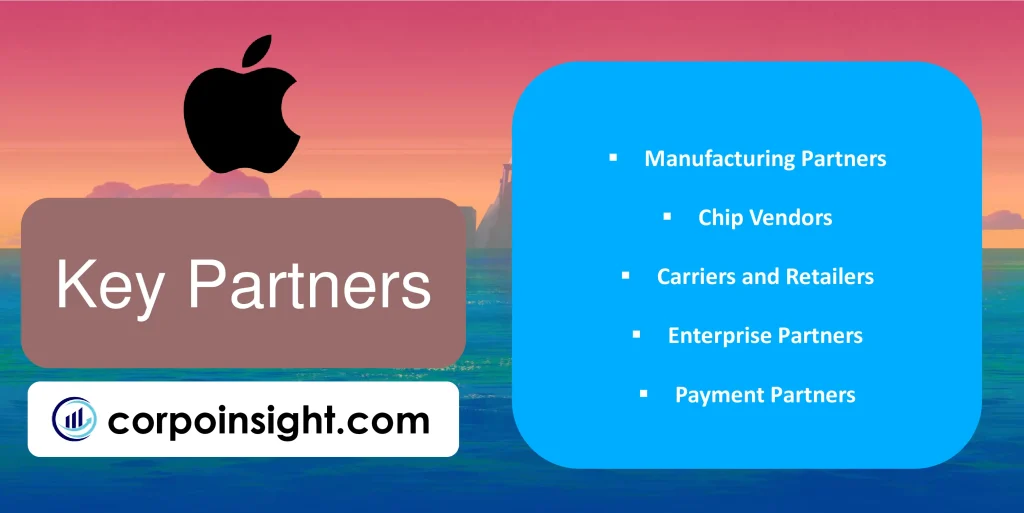
Manufacturing Partners: Major partners like Foxconn, Pegatron, Wistron, and others comprise a network of suppliers and manufacturers that help Apple achieve scale and localization needs globally to produce over 250 million Apple devices annually.
Chip Vendors: Key semiconductor partners provide components critical for Apple’s custom silicon chips and processors, such as TSMC fabricating Apple’s latest A16 and M2 SoCs on cutting edge 3nm and 5nm processes showcasing collaborative innovation.
Carriers and Retailers: Partnerships with leading carriers like Verizon and retailers like Best Buy are important for expanding iPhone and devices’ reach via cellular plans, promotion of effective store-within-store launches, and hands-on demo presence.
Enterprise Partners: Apple enterprise partnerships with IBM, SAP, Cisco, and more have been vital for large corporate iOS device rollouts via bundling customized software, support, and services tailored to the needs of Fortune 500 deployment, management, and productivity.
Payment Partners: Apple Pay ties major credit card networks like Visa and Mastercard, issuing banks worldwide, plus merchants accepting contactless Apple Pay for tap-to-pay convenience and integrated digital wallet acceleration.
Cost Structure – Apple Business Model Canvas
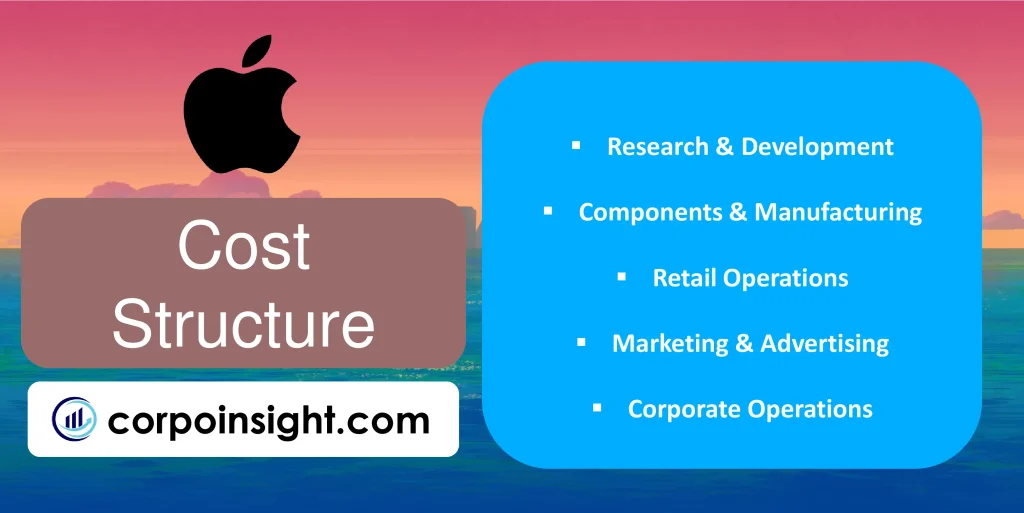
Research & Development: Apple has substantial R&D expenditures, spending over $20 billion in 2022. Investments in pioneering proprietary technologies in silicon, software, and services feed current and future innovations across the iPhone, iPad, Mac, and ecosystem.
Components & Manufacturing: Raw component materials tied to iPhone, iPad and Mac bill of materials plus associated manufacturing labor are estimated to comprise nearly 50% of costs. Recently, supply shortages and microprocessor demand increased prices.
Retail Operations: With over 500 impressively designed global retail stores, staffing highly trained employees to deliver service experiences contributes significantly to costs but pays dividends for customer acquisition and organic growth.
Marketing & Advertising: Apple’s sophisticated multi-channel advertising campaigns and brand marketing teams focused on digital, TV, billboards, influencers, and storytelling are credited for increasing brand affinity and demand despite commanding premium pricing.
Corporate Operations: International business teams covering 150+ countries, compliance functions around data privacy, app standards, various regional headquarters, plus cloud infrastructure comprise key global operational expenditures.
Summary of Apple Business Model Canvas

Conclusion on Apple Business Model Canvas
Apple has created a powerful, highly profitable business model by controlling premium hardware and software innovation to deliver an industry-leading user experience with deep integration across Apple’s services and a rapidly growing ecosystem. Using vertical integration plus leveraging world-class industrial design, brand loyalty, and multi-channel retail, Apple commands price premiums, recurring subscriptions, and durable customer relationships – fueling over $394B in annual revenues.

Hi! I am Mohammad Safayet Hossain, pursuing my BBA in Marketing at the Bangladesh University of Professionals. As a business student, I am passionate about learning about various companies and industries and am here to share them with you.

